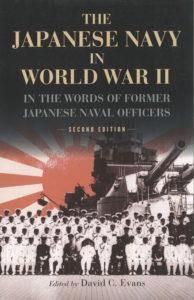 Edited by David C. Evans, Naval Institute Press, Annapolis, MD (Hardcover,1986; Paperback, 2017)
Edited by David C. Evans, Naval Institute Press, Annapolis, MD (Hardcover,1986; Paperback, 2017)
Reviewed By: Michael F. Solecki
The Japanese Navy In World War II is a collection of interviews/essays previously published in various volumes of the United States Naval Institute’s Proceedings, as well as other publications from the 1950s and 1960s by former witnessing officers of the Imperial Japanese Navy. I read the “first edition” of this book more years ago than I would like to admit, and the hard copy of the “second edition” somewhere between then and now. It surprised me to see it twenty or so years later on the Naval Institute Press (NIP) display table at this year’s Society of Military History annual meeting in Jacksonville. Something in the back of my head compelled me to buy it knowing that I already had it at home and already read it. I started rereading it on the train ride back to New Jersey finding I could not put it down. I’m glad that I picked it up, and that the Naval Historical Foundation allowed me to review it. Having to critique it with years of added knowledge gave me a different and more in-depth perspective of what these Japanese officers thought of their part in the war; while helping me out of a “perspective” rut I didn’t even know I was in. I guess fate intervened. Even if you already read the book, you may want to give it another look.
The older work began by organizing it in somewhat of a chronology of major events in the war of the Pacific as the Japanese officers that lived it, saw it. In this edition, Evans continued this concept but, took it further by updating and revising some of the translations of the first edition and extending the already more than adequate “Notes” section. Evans, also ground-truths the facts throughout the entire narrative and as in the first edition includes incisive introductions for each of the new chapters. Both include Pearl Harbor, Midway, the Kamikaze and the use of “big guns,” like the Yamato, their fallacy and what led to them being for the most part, obsolete. The new edition not only includes an updated version of the first but, Evans added the Japanese perspective of the Indian Ocean operations, Taiwan air war, anti-submarine warfare, Japan’s concept of submarine tactics, Okinawa and a hefty relevant section on Vice Admiral Ozawa by one of his aides. The officers’ opinions of the Japanese high command’s obsession with the necessity for a decisive battle of great fleets to win the war is emphasized throughout the essays.
As with any work on “perspective,” it is just that: perspective. The nightmare of many historians is evaluating the “truth” quality of a perspective especially after the subjects have passed. From the losing side normally you get the usual collection of negatives, the nay-sayers, mal-contents, sore losers and the like. However, the editors of this collection of essays deserve kudos for not only their choices but, their added insight. O’Conner’s work in the first volume was state of the art for the time. Evans came by fifteen or so years later and revitalized and revised the first edition and filled several gaps; also, adding several relevant illustrations and photos. Evans also added an essay by Rear Admiral Yokoi Toshiyuki and his thoughts on Japan’s loss of the war. It is the last chapter in the book, but you may, especially if you are new to the subject or a casual reader, want to it read right after O’Conner’s and Evans’ prefaces (which should not be skipped) and the “Introduction” then, read it again in its original place. It will set the tone for the rest of the book and then give closure at the end. Having dusted off the “original” first edition, I did a technical comparison to the revised content in the new edition and found the Evans translation smoother to read and understand and the edition to still be relevant by today’s standards.
The composition and format made the reread of this work worthwhile by helping me realize that I was becoming complacent with my ideas of revisionism in search of the truth. So, thank you Naval Institute Press for the timely reprint. I highly recommend reading (or rereading as in my case) the second edition it was hard to put down but, way too long and detailed to do in a sitting and still comprehend. David C. Evans (1940-1999), has other comprehensive publications on the Imperial Japanese Navy all deserving a look.
Michael F. Solecki, is an independent naval historian, holds a Master of Arts in Military History from Norwich University as well as undergraduate degrees and graduate certificates in engineering and physical sciences, is a veteran of the U.S. Navy and NOAA.

